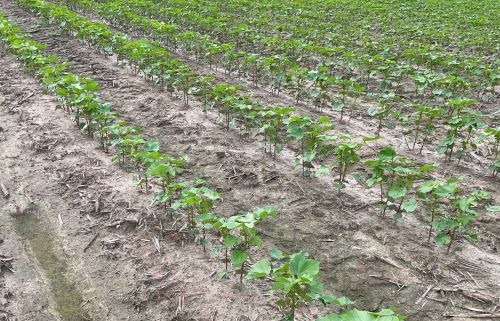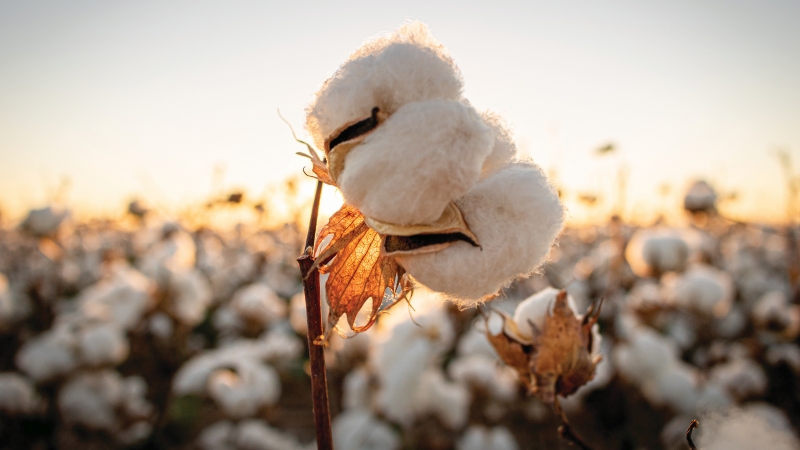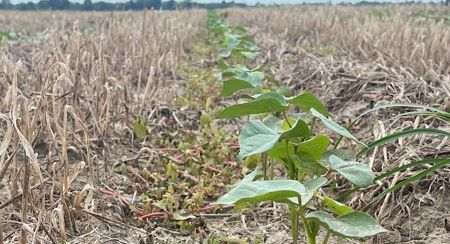Crop Scan Ag Report: Cotton Planting Moving Quickly, Early Season Treatments Begin
After a wet spell two weeks ago, planters have been playing catch up and are moving quickly across most areas of the Cotton Belt. Thrips, weeds, and other early season pests are starting to catch growers’ attentions as well, and treatments are starting when and where needed.
Here’s what our contributing consultants had to report for early June.
Chad Harrell owns and operates Harrell Agronomic Services in Northeastern North Carolina.
All of our cotton acres have been planted over the past two weeks. We do still have a few growers that are replanting in the areas that received heavy rains a week ago. These acres should be completed over the next few days as fields continue to dry out.
Our earliest planted cotton is now at the 6th leaf stage and growing off nicely. The cotton that was planted in the second half of May is still receiving thrips and herbicide applications. Thrips applications seem to be working well, as we have seen much better conditions than last year.
Wes Briggs consults on cotton, corn, peanuts, soybeans, and small grains for growers in Georgia, Alabama, and Florida.
I would say my growers are about 80% planted on cotton. Our oldest cotton has some pinhead squares on it, and we’re still planting cotton behind sweet corn. We just had some recent rains. One area had 4 inches yesterday, but we had a gentle rain pretty much across the board over the last couple of days.
Thrips pressure has been light to moderate compared to the last several years. We’re starting to sidedress some cotton with fertilizer. We do a lot of split application of potash and nitrogen on sandy soils, and we’re on our first application. We’re also into our first post over-the-top herbicide applications. We haven’t sprayed long enough to see results yet, but we got some rigs in the field last week and people will be running wide open this week.
No real issues, knock on wood. Our stands are pretty average. We’re still trying to get our feet back under us from earlier in May when we missed 10-14 days of planting in our prime window. Last week was a good week. Tractors were back in the fields, and we got a lot done. But we’re still a bit behind.
We have a wide range of cotton in our area, just like we normally do. We’ll plant cotton in some of these double crop fields for the next seven days or so here, then switch and go to soybeans.
Tucker Miller is a Mississippi-based independent private consultant for cotton, soybeans, corn, peanuts, rice, and vegetables.
Our cotton has all been planted. Cotton ranges from nine nodes to four true leaves. We have a small number of acres that have just come up. They had to be replanted due to hail damage. For the most part, we have gotten off to a really good start.
 Photo: Tucker Miller
Photo: Tucker Miller
We are applying herbicides to clean up weeds at this time. We are also applying fertilizer now. Our rainfall has been perfect up to this point, but I know it will cut off soon.
The insect situation has been low thus far. We are sweeping the squaring cotton now for Lygus bugs, and I expect them to pick up this week as corn is tasseling now. We will be looking at growth regulators on the nine and ten node cotton this week as well.
The corn is all laid by and starting to tassel. All poly pipe is laid, and we’ll start water as needed. We haven’t had to irrigate yet due to ample rainfall.
Soybeans are mostly at R2 and are looking good. No insect pressure yet.
Mark Nemec is an independent agricultural consultant for cotton, wheat, grain sorghum and corn in the Blacklands and Brazos River Bottom area of Central Texas.
Not much has changed here in Central Texas in the last few weeks. It is still wet over much of the area, with rainfall every few days or so.
Some of the storms brought torrential rain, some scattered hail storms, and very gusty winds that damaged some of the cotton that was up and growing. The Brazos River Bottom did get most of the fields planted as well as the southern part of the Blacklands. There are some locations that need to be replanted if possible. The northern part, however, only got about 25% planted. With our insurance deadline here now and wet fields, it looks like the planters are done for the year.
Weeds have been a problem in many locations. Whenever the ground will hold up a sprayer (or not), applications are going out to try and reclaim the fields. Harvest will be pretty rough with all the ruts we are cutting.
The cotton on high ground has progressed nicely with the heat and a few sunny days. Square set is good despite the weather. Fleahoppers are numerous in the cotton as well, but so far we have been able to stay on top of them.
Kerry Siders is Texas A&M AgriLife Extension Agent-IPM for Hockley, Cochran, and Lamb Counties.
Cotton here on the western portion of the Southern High Plains of Texas is mostly planted with exception of some dryland acres and replanting of weather damaged acres.
The May 29 storm which blew through portions of Cochran and particularly Hockley County were extremely devasting to crops, pivots, and structures. Please keep all those affected in prayer. The storm brought some rain, but intense large hail and high winds caused great damage. So, things are in flux for a while until weather settles, wind lays, adjusters visit fields, and we get some crop up and making progress.
I want to revisit how we approach cotton stand evaluations. Most of our cotton acres are on 40” rows, so we generally count the number of plants in 13’ of row (1/1000th of an acre). We would consider 26 plants (2 plants per foot) in that 13’ space to be 26,000 plants per acre. This would be a minimum good stand on irrigated cotton. Ideally, your stand would have closer to 40,000 plants per acre or closer to 3 plants per foot. Dryland acres can dip down into the 19,000 range or 1.5 plants per row foot. In either situation, if you get much below these standards, you most likely need to replant cotton if time allows or move to another crop.
Currently, we are scouting for thrips and evaluating wireworm damage. Weeds have been dealt with up till now by planting on clean ground and having at-plant pre’s in place. As we move through June, we will need to supplement this weed control with post and additional pre herbicides.















